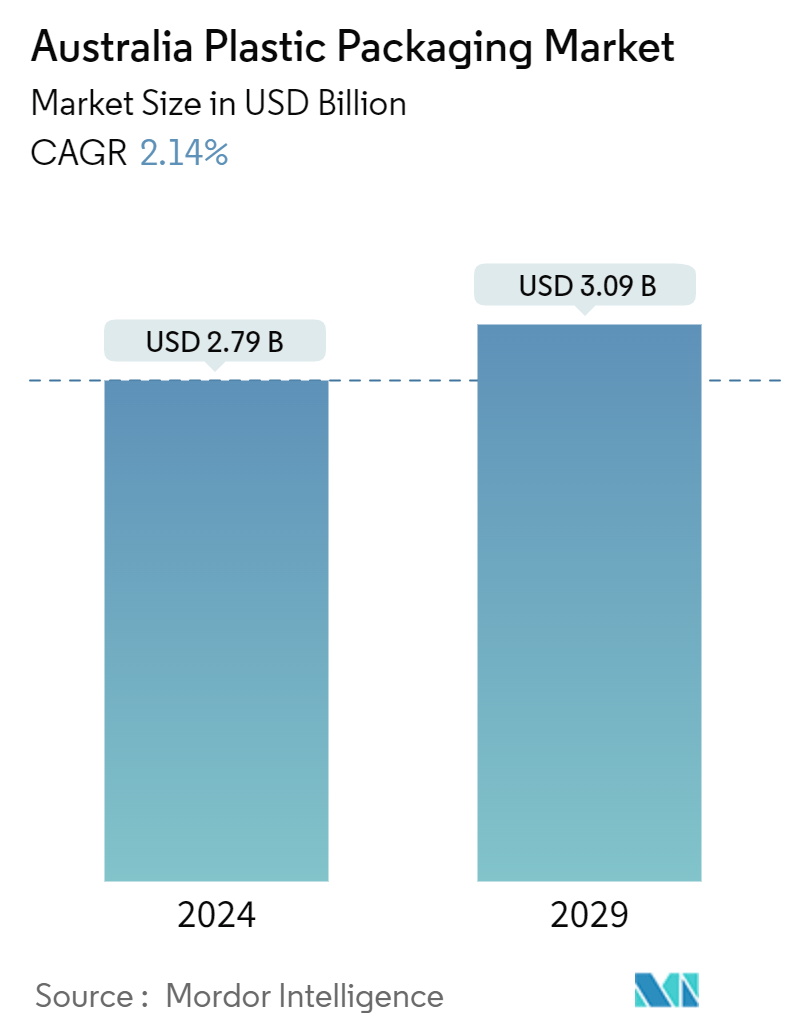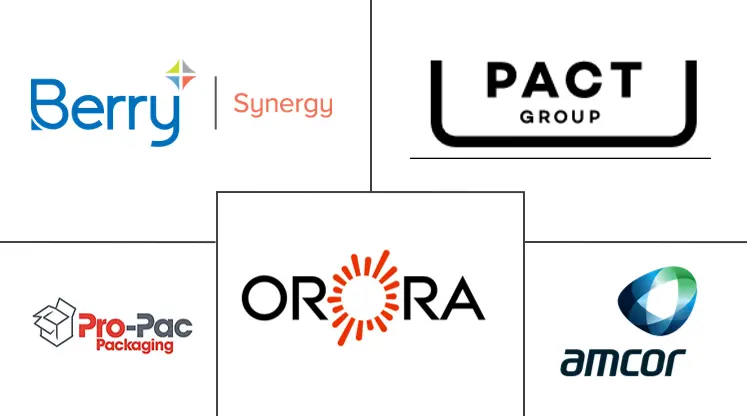Market Size of Australia Plastic Packaging Industry

| Study Period | 2019 - 2029 |
| Base Year For Estimation | 2023 |
| Market Size (2024) | USD 2.79 Billion |
| Market Size (2029) | USD 3.09 Billion |
| CAGR (2024 - 2029) | 2.14 % |
| Market Concentration | Low |
Major Players
*Disclaimer: Major Players sorted in no particular order |
Australia Plastic Packaging Market Analysis
The Australia Plastic Packaging Market size is estimated at USD 2.79 billion in 2024, and is expected to reach USD 3.09 billion by 2029, growing at a CAGR of 2.14% during the forecast period (2024-2029).
The increasing demand for plastic packaging in Australia is attributable to the country's increasing food and beverage consumption. Increasing tourism, a busy consumer lifestyle, and a preference for convenient products have also enhanced the demand for plastic packaging.
- Australia witnessed a significant increase in population in the previous decade. It is anticipated to drive the demand for consumables, such as beverages, which include alcoholic and non-alcoholic liquids, packaged meals, and packaged drinking water, which prefer plastic packaging medium over other alternatives, owing to high portability enabled by the lightweight of the plastics.
- According to data from the United States Department of Agriculture (USDA), Australia's food, beverage, and grocery sectors dominate the manufacturing arena, accounting for a third of the nation's manufacturing activity. This sector comprises over 16,000 enterprises, including numerous solo traders and small to medium-sized enterprises (SMEs). The growth of the food processing industry is primarily fueled by price hikes, increasing domestic demand, and a surge in exports, all of which are catalysts for market expansion.
- The Australian plastic packaging market is witnessing a surge in product innovations, particularly in sustainable products. Key players such as Amcor Group GmbH and Pact Group are spearheading this movement, emphasizing innovative and eco-friendly packaging solutions. Notably, in January 2024, Amcor's commitment to sustainability was underscored when it was lauded as a sustainable packaging leader by the Dow Jones Sustainability Indices (DJSI) Australia.
- However, the growing environmental concerns toward plastic packaging waste in Australia is a major challenge for the market's growth. According to the Australia Institute, Australia is projected to more than double its plastic consumption by 2050. However, despite governmental efforts to foster a 'circular economy,' only 14% of plastic waste is diverted from landfills, impeding the demand for plastic packaging. As a result, manufacturers in the country are resorting to the use of plastic alternatives, including metal and paper, for packaging.
Australia Plastic Packaging Industry Segmentation
Plastics are used in packaging materials for food, beverages, and oil. They are used mainly because of their performance, cost-effectiveness, and durability. Depending on the type of product being packed, plastics can be of different grades and material combinations, such as polyethylene, polypropylene, and polyvinyl chloride.
The Australian plastic packaging market is segmented by rigid packaging (material (polyethylene terephthalate (PET), polypropylene (PP), polystyrene (PS) and expanded polystyrene (EPS), polyvinyl chloride (PVC), and polyethene (PE)) and product (bottles and jars, trays and containers, and other product types)), flexible packaging (material (polyethene (PE), bi-orientated polypropylene (BOPP), cast polypropylene (CPP), polyvinyl chloride (PVC), and other flexible packaging materials) and product (pouches, bags, films and wraps, and other product types)), industrial plastic film market (stretch film and agricultural film), and end-user industry (food, beverage, healthcare, personal care and household, and other end-user industries). The market sizes and forecasts are in terms of value (USD) for all the above segments.
| Rigid Packaging | |||||||
| |||||||
|
| Flexible Packaging | |||||||
| |||||||
|
| Industrial Plastic Film Market | |
| Stretch Film | |
| Agricultural Film |
| End-user Industry | |
| Food | |
| Beverage | |
| Healthcare | |
| Personal Care and Household | |
| Other End-user Industries |
Australia Plastic Packaging Market Size Summary
The Australian plastic packaging market is poised for steady growth over the forecast period, driven by increasing demand for convenience and portable food packaging. The market's expansion is supported by the rising population and lifestyle changes that favor single-serve and lightweight packaging solutions. Despite efforts to reduce plastic usage, the benefits of plastic packaging, such as portability and cost-effectiveness, continue to drive its adoption across various sectors, including food and beverage, eCommerce, and healthcare. The government's 2025 National Packaging Targets aim to promote sustainability and recyclability, encouraging manufacturers to innovate and adopt circular economy practices. This regulatory framework is expected to shape the market dynamics, pushing for increased use of recycled materials and alternative packaging solutions.
The market landscape is characterized by a high level of fragmentation, with numerous players competing on the basis of product differentiation, particularly in terms of recycled content and ease of recyclability. Companies are actively engaging in partnerships and innovations to meet the growing demand for sustainable packaging solutions. The Australian government's initiatives, such as the National Plastics Plan and various collaborations with industry leaders, are fostering a conducive environment for market growth. These efforts are complemented by advancements in packaging technology and infrastructure, aimed at enhancing recycling capabilities and reducing plastic waste. As a result, the Australian plastic packaging market is expected to witness continued investment and development, aligning with both domestic and international sustainability goals.
Australia Plastic Packaging Market Size - Table of Contents
-
1. MARKET INSIGHTS
-
1.1 Market Overview
-
1.2 Industry Value Chain Analysis
-
1.3 Industry Attractiveness - Porter's Five Forces Analysis
-
1.3.1 Threat of New Entrants
-
1.3.2 Bargaining Power of Consumers
-
1.3.3 Threat of New Entrants
-
1.3.4 Threat of Substitute Products
-
1.3.5 Intensity of Competitive Rivalry
-
-
-
2. MARKET SEGMENTATION
-
2.1 Rigid Packaging
-
2.1.1 Material
-
2.1.1.1 Polyethylene Terephthalate (PET)
-
2.1.1.2 Polypropylene (PP)
-
2.1.1.3 Polystyrene (PS) and Expanded Polystyrene (EPS)
-
2.1.1.4 Polyvinyl Chloride (PVC)
-
2.1.1.5 Polyethene (PE)
-
-
2.1.2 Product
-
2.1.2.1 Bottles and Jars
-
2.1.2.2 Trays and Containers
-
2.1.2.3 Other Product Types
-
-
-
2.2 Flexible Packaging
-
2.2.1 Material
-
2.2.1.1 Polyethene (PE)
-
2.2.1.2 Bi-orientated Polypropylene (BOPP)
-
2.2.1.3 Cast Polypropylene (CPP)
-
2.2.1.4 Polyvinyl Chloride (PVC)
-
2.2.1.5 Other Flexible Packaging Materials
-
-
2.2.2 Product
-
2.2.2.1 Pouches
-
2.2.2.2 Bags
-
2.2.2.3 Films and Wraps
-
2.2.2.4 Other Product Types
-
-
-
2.3 Industrial Plastic Film Market
-
2.3.1 Stretch Film
-
2.3.2 Agricultural Film
-
-
2.4 End-user Industry
-
2.4.1 Food
-
2.4.2 Beverage
-
2.4.3 Healthcare
-
2.4.4 Personal Care and Household
-
2.4.5 Other End-user Industries
-
-
Australia Plastic Packaging Market Size FAQs
How big is the Australia Plastic Packaging Market?
The Australia Plastic Packaging Market size is expected to reach USD 2.79 billion in 2024 and grow at a CAGR of 2.14% to reach USD 3.09 billion by 2029.
What is the current Australia Plastic Packaging Market size?
In 2024, the Australia Plastic Packaging Market size is expected to reach USD 2.79 billion.

